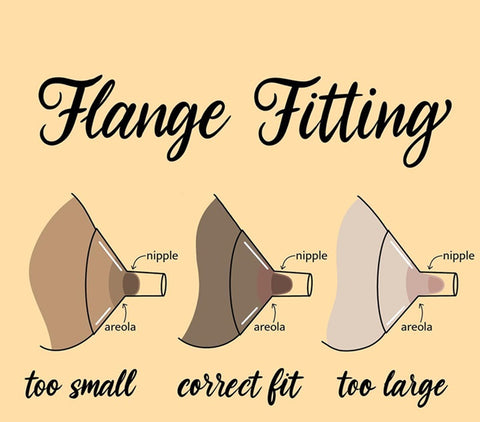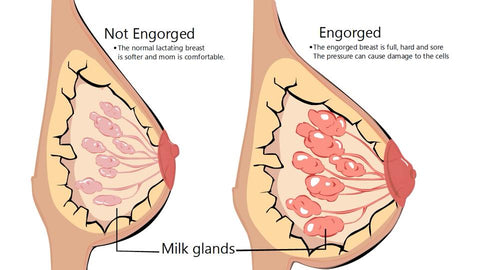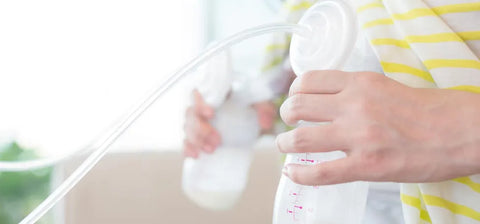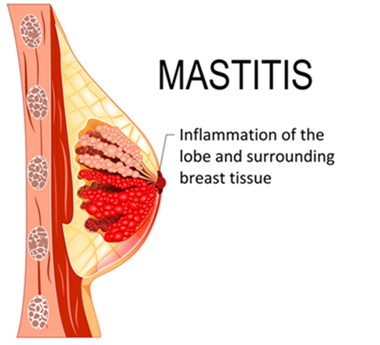Just like breastfeeding, using a breast pump should be an easy and smooth process. However, most women feel breast pain after pumping. Incorrect usage of breast pumps can lead to pain and can damage breasts or nipples. Using breast pumps correctly not only prevents issues but also helps in removing the milk more efficiently. Whether you pump occasionally for back up or use the pump multiple times in a day, understanding common mistakes and avoiding them can help prevent breast injury and pain.
Is it normal for breast to hurt after pumping?
It depends. While mild discomfort can be expected, persistent or severe pain is usually a sign that something isn't quite right, and could indicate breast tissue damage.
“The first few times you pump may feel uncomfortable but pumping should not be painful, result in sore nipples, or cause bleeding. Pain, sore nipples, and nipple irritation or bleeding may be signs of an injury.”
Source: FDAWhat's considered normal discomfort:
- Slight tenderness, especially for new moms adjusting to pumping.
- A brief stinging sensation in the early postpartum period.
- Mild discomfort in the first 10–15 seconds as the nipples stretch.
- Temporary aching from engorgement if you have an abundant milk supply.
When should you see a doctor?
If you experience any of the following, it could be a sign of breast tissue damage from pumping and you should seek medical attention:
- Persistent pain even when you're not pumping;
- Sharp pain that begins within the first 2 minutes of pumping and doesn't subside.;
- Redness, swelling, warmth, or hard lumps in the breast.;
- Severe pain with blood in your milk.;
- Skin changes, such as blisters, cracks, or sores, which could indicate a fungal infection like thrush.
Common Causes of Breast Pain After Pumping
We often see many mothers ask in breastfeeding community: "Why does it hurt when I pump?" "Why do my breasts hurt after pumping?" There are different factors that can be responsible for breast hurt after pumping. We have listed some of the common causes for this irritation.
Incorrect Flange Size or Improper Pump Fit
Flanges are the horn-shaped breast shields placed over the areola while pumping. Using the incorrect flange size can have a drastic impact on the comfort level as well as the output during and after your pumping session, thereby leaving your breast sore after pumping.
When you buy your pump, you are normally given an average-sized flange. But since every nipple is different, one size doesn’t fit all.
A critical rule is: your flange size = nipple diameter + 3 to 5mm.
A small air space allows for natural nipple expansion during pumping. You need to look up your pump brand online and order a flange size that suits you.
Want a step-by-step guide? Read our Find Your Fit: What Size Breast Pump Flange You Need

Engorgement or Oversupply Issues
If you experience nipple pain after pumping, chances are high that your breasts are engorged. Let us know a bit more about engorgement.
Engorgement happens when your breasts become overly full, leading to swelling, tightness, and discomfort.
Once your transitional milk comes in on about the 3rd or 4th day after birth, your breasts grow larger and heavier as they fill with fluid.
If milk isn't removed regularly—whether through nursing or pumping—engorgement can worsen, causing rock-hard breasts and flattened nipples. This can make them unable to move freely in the pump.
“Engorgement can lead to plugged ducts or a breast infection, so it is important to try to prevent it before this happens.”
Source: Womenshealth.govPro Tip: For many breastfeeding mothers, overnight engorgement is a common and uncomfortable reality. Read our guide on How to Prevent Engorgement Overnight: Causes and Effective Solutions

Incorrect Pumping Technique or Settings
If your nipple hurts after pumping, your pump setting can be the culprit behind this. It’s important to adjust the suction strength to a level that feels comfortable for you.
Remember, the highest suction level is not always the best choice.
Start by selecting the lowest setting and gradually increase it step by step until you find the suction strength that works best for you.
Pumping should never be painful—discomfort can not only make pumping unpleasant but may also reduce the amount of milk you express.

Vasospasm & Nerve Sensitivity
A vasospasm occurs when the blood vessels in the nipple tighten suddenly. It is usually because of cold exposure after breastfeeding or pumping. This constriction limits blood flow to the area, causing pain.
This pain is typically deep, throbbing, or stabbing. The common signs of vasospasm include sharp or pulsating pain in the nipple, as well as color changes in the nipple. The nipple may turn white, then blue or red as blood flow returns.
Clogged Milk Ducts
Clogged milk ducts are a common challenge for breastfeeding parents, especially during the early postpartum weeks (around 2–4 weeks) or when transitioning to weaning. They can also happen if you go too long between feedings or pumping sessions, or if your breast pump isn’t being used properly.
If you have a clogged duct, you might notice:
- a tender, localized lump in the breast (often the size of grape),
- firmness and soreness in one area of the breast,
- or mild redness or warmth over the affected spot
“If you have a fever or other symptoms then you probably have a breast infection rather than plugged ducts.”
Source: Womenshealth.govIf left untreated, a clogged duct can turn into mastitis, a painful breast infection.
Mastitis or Other Breast Infections
Breastfeeding women are most likely to get mastitis, a type of breast infection that often develops due to cracked nipples or clogged milk ducts. The common symptoms of mastitis are
“tender or painful; hot; reddened; hard and swollen. Other symptoms can include: The skin may appear tight and shiny, and be streaked with red. You feel very ill (‘fluey’) and have a high temperature (over 38 °C).”
Source: Better Health Channel (Victoria, Australia)Such types of infections can occur when bacteria enter the breast tissue, leading to inflammation and infection. It often needs treatment by a medical professional. If you feel you are suffering from a possible breast infection, stop pumping and feeding your baby the affected milk and get in touch with your doctor.

Damaged or Irritated Nipples
If you feel pain that is burning, stabbing, or feels like pins and needles, then these might be signs of nipples damage from pumping. You might also notice your nipples turning white, then red or blue. Tender, chafed, or sore nipples can develop into cracks or open wounds, thereby causing breast pain while pumping.
How to Address Painful Pumping: Expert Tips
Several factors may contribute to painful pumping. To effectively alleviate the discomfort, it’s important to first identify the cause of the pain and then address it accordingly.
To help alleviate discomfort while pumping, expert Jessica Anderson (MA, IBCLC, CLC) shares valuable tips in this video. She explains that there are multiple factors contributing to breast pain during pumping and emphasizes the importance of ensuring that your flange fits properly and provides sufficient support.
Jessica also advises checking for underlying infections, adjusting suction levels gradually, and understanding the role of oxytocin in easing pain.
For additional relief, remember to:
- Adjust flange size and position: Make sure your nipple moves freely in the center of the flange, with the areola being only slightly pulled.
- Gradually adjust suction levels: Start with a stimulation mode to trigger the milk reflex. Then, increase to a comfortable suction level that doesn’t cause pain. Try to match the rhythm of a baby’s natural suckling.
- Reduce tissue swelling: Before pumping, press your thumb gently on the areola for 5 seconds and release. Repeat this 3 times to help reduce tissue swelling.
- Ease Engorgement with Warmth: To encourage milk flow and relieve engorgement before feeding, try warming your breasts with a warm, moist washcloth or taking a warm shower for 10–20 minutes. This helps stimulate let-down and makes nursing more comfortable (Source: USDA's WIC).
- Cold compress after pumping: According to ABM ( Academy of Breastfeeding Medicine), cold reduces pain and inflammation. After pumping, apply cold packs or moist, cool cloths to your breasts for 15-20 minutes to get relief from the pain.
- Massage during pumping: Gently massaging your breasts during pumping can help with milk flow and reduce discomfort. For a detailed guide on effective techniques, check out how to massage your breast while pumping.
- Use vegetable glycerin gel pads: They have a cooling effect on chafed and sore nipples, offering instant relief, and can easily be worn in bras.
- Moisturize cracked nipples: If you have cracked nipples due to pumping, apply moisture on open wounds. Research shows that this can help the wounds heal up to 50% faster and lower pain. Consider using an all-natural ointment that protects and soothes your nipples.
- Ask for Professional guidance: If you are still experiencing pain after trying these tips, don’t hesitate to consult a lactation consultant.
How to Prevent Breast Pain After Pumping
Try these tips to prevent breast pain after pumping.
- Proper breast care: A proper and clean washing of hands before touching pump equipment or breasts is recommended. Clean your breasts once a day with water only, avoiding harsh cleaners. If you experience cracked skin or discomfort, consider using a gentle cream or natural oils for nourishment and healing.
- Choose the right flange size: Place the flange on your breast before a pumping session to ensure it fits correctly. It must create a seal by covering your areola and nipple, and the tunnel of the flange must fit over your nipple, leaving about 3–5mm of extra circumference around it.
- Adjust pump settings properly: Speaking about the breast pump settings, increase the suction gradually after your breasts have started to leak milk. If you feel pain while breastfeeding, lower the suction a bit.
- Choose a smarter, more comfortable breast pump: As the expert mentions, many breast pumps feel like “robot babies,” lacking the warmth and comfort a real baby provides. The eufy wearable breast pump S1 Pro is a game-changer for addressing this issue and other painful pumping experiences. With HeatFlow™ technology, revel in revolutionary comfort reminiscent of your baby's embrace, effectively reducing clogged ducts and enhancing milk flow and output. Crafted with 105° angle flanges and soft silicone, the pump prioritizes your comfort during each session, ensuring a gentle and snug fit.
- Massage & warm compress before pumping: Also, massaging your breast and nipple after pumping can cause relief and lessen skin sensitivity as well as build elasticity. Massaging before pumping can increase the milk flow as well.
- Maintain proper pumping posture: Ensure that your breasts are positioned correctly in the pump's flange. Use pillows or armrests to keep your body supported and relaxed.
- Use lanolin or coconut oil on nipple: These natural products help keep your nipples moisturized and prevent dryness or cracking.
- Have a regular and scientific pumping schedule: CDC (Centers for Disease Control and Prevention) mentions that regular pumping or breastfeeding can help prevent breast engorgement. Aim for 8–12 pumping sessions per day, and try to stick to a consistent schedule. Over-pumping can also lead to engorgement.
Related Blogs
Check out these articles for more information:
Conclusion
As mentioned earlier, breast pumping should not be a difficult task for you. Watch out for the common causes for the pain and treat them immediately to avoid further hassle and trouble. If you feel breast pain after pumping, you can try different tips to get instant relief. If you continue to feel the pain or have sore nipples after pumping, make an appointment with your healthcare provider. They can offer you with correct treatment, guide you know how to use the breast pumps correctly, and provide tips on how to deal with the pain after pumping.
FAQ
Is it normal for breast to hurt after pumping?
It's common for breasts to feel tender or sore after pumping, especially if you are new to it or if you are pumping more frequently than usual. But if you feel persistent or severe pain is usually a sign that something isn’t quite right.
How to relieve breast pain after pumping?
You can try different methods to find instant relief from pain after pumping. This includes applying hot and cold compress, using a gentle massage, expressing milk by hand, using a proper support bra, checking for correct pump setting, and over-the-counter medicines, among others.
How can I maintain my milk supply if pumping is painful?
If you feel pain after pumping but want to maintain milk supply, you can hand express milk instead of using a pump. Hand expression can be gentler on the breasts and may be less painful.